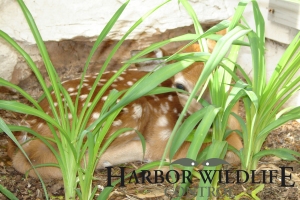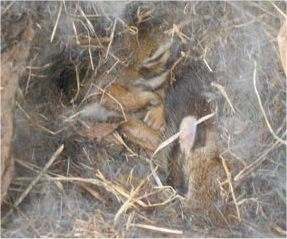 Whitetail Fawn “Many people who come upon a solitary spotted fawn in the woods or along a roadway mistakenly assume the animal has been deserted by its mother and want to take the apparently helpless creature home to care for it,” “Young fawns like this have not been abandoned but are still in the care of a doe.” |
The Problem
Every year, many people upset the lives of young wildlife when they only mean to help. They take fledgling songbirds, young rabbits or other animals from the wild in a mistaken attempt to save them. This brochure is intended to help you decide when help is needed and when to leave well enough alone.
Why It Happens
The arrival of spring and summer also means the arrival of newborn and just-hatched wildlife. These young soon venture into the world on shaky legs or fragile wings. While most are learning survival from one or both parents, some normally receive little or no parental care. Often, wild animal parents stay away from their young when people are near. For all of these young animals, the perils of survival are a natural part of life in the wild. Some will not survive. However, young wildlife that learn well and are the most fit usually live the longest.
Those early unsteady steps and flights are part of normal development, helping young animals learn to take care of themselves. Some quickly develop that ability, almost from birth. For example, snowshoe hare, turtles and snakes are ready to venture into the world within hours of birth or hatching. Other animals need more parental care. For example, cottontail rabbits are born with no fur and closed eyes, unable to leave their nest on the ground surface for several weeks and continue to nurse from the mother for another week or more. Most young songbirds likewise spend about two weeks in the nest and then follow their parents about for days, begging for food and learning to fly well.
So, it's not unusual to see a young robin crouched on the lawn or a young rabbit in the flower garden, both apparently motherless. Or, to find a fawn lying by itself. Often, we step in to help. This is when problems arise; when we assume that young wildlife we find alone are abandoned, helpless and need saving. In nearly all cases, this is a mistake.
The Result
These well-meant acts of kindness tend to have the opposite result. Most people quickly find that they do not really know how to care for young wildlife, and many of the animals that are "rescued" soon die despite their best efforts.
 Baby Rabbits - Leave Them Be ! |
Even if they do survive in our care, these young wild animals have missed the natural experiences that teach them to fend for themselves. When these wild animals are released back into the wild it is difficult for them to function as they should (for example, their ability to find natural foods is impaired) and they have a reduced ability to survive. Further, they may be thrust as unwelcome intruders into the home range of another member of their species.
Also, the care given to young wildlife often, unavoidably, results in some attachment to humans. On release to the wild, those animals generally have little fear of people. Some return to places where people live, only to be attacked by domestic animals or to be hit by cars. Some become nuisances getting into stored food, trash cans or dwellings. People have also been injured by once-tamed wildlife.
What To Do
All of these problems can be avoided by following one simple rule when coming upon young wildlife: LEAVE THEM ALONE! It may be difficult to do, but this is the real act of kindness and in nearly all cases that is the best thing to do.
DO NOT consider young wildlife as possible pets. This is illegal and is bad for the animal. Furthermore wild animals do not make good pets; they are not well suited for life in captivity and they may carry diseases that can be given to people. Resist the temptation to take them out of the wild.
However, when you encounter a young wild animal that is obviously injured or orphaned, you may wish to call a Wildlife Rehabilitator for advice and help. Wildlife Rehabilitators, volunteers licensed by DEC, are the only people legally allowed to receive and treat distressed wildlife. They have the experience, expertise and facilities to successfully treat wild animals. The goal of the rehabilitator is to release a healthy animal back into the wild, where it belongs.
To locate a Wildlife Rehabilitator in your area, call your nearest Regional Wildlife Office.
Please note that not all rehabilitators will accept all species of wildlife, especially animals like raccoons, skunks or bats which are the most common carriers of the rabies virus.
Common questions and answers about young wildlife:Q. This morning I found an "abandoned" fawn near the edge of a field on my property. I brought the fawn into my house to save it, but I don't know how to care for it. What should I do?
A. In most cases, the fawn probably isn't abandoned. Immediately take the fawn back to the spot where you found it and leave it there. The mother should come back again looking for the fawn. Even one to two days after removal from the wild, fawns have been successfully reunited with their mothers by returning them to the place where they were found. When you picked up the fawn, the mother was probably not far away. Usually, young fawns are quite safe when left alone for the day by their mother.
Q. I just found a fawn near the edge of a road. Is it wise to stop and chase it from the side of the road ?
A. NO! This may seem like the right thing to do but it not only puts you in danger it will put other motorists on the roadway in danger should the fawn "not listen" to you and run into traffic ultimately killing the fawn. It is best to leave the animal alone.
Q. A very small baby bird has fallen from its nest in a tree in my backyard. I am afraid something might happen to it if I leave it there on the ground. Should I bring it into the house and feed it until it is able to fly?
A. No. The best thing to do is put the bird carefully back into the nest (or the nest itself back into the tree). But, do this ONLY IF YOU CAN DO IT SAFELY. Don't worry about getting your scent on the bird. Also, some birds that appear to have fallen from the nest are actually recently fledged and are learning to fly. They will not stay in the nest.
Q. A few minutes ago, I was walking through the woods behind our house and saw several young raccoons on the ground near a large hollow tree. I wonder if they fell out of the hole way up in the tree and the mother has abandoned them because she can't put them back in their nest. Should I bring them home and care for them?
A. No. Most likely, the young raccoons are merely exploring and their mother is nearby. They are probably old enough to be fully capable of climbing back up the tree to their den when they are ready to return. If they were too young to climb, the mother would carry them back. Also, you must remember that raccoons can carry rabies and can transmit it to humans, so do not attempt to handle them.
Q. There is a young blue jay in my backyard and it seems to be having difficulty flying. I am afraid that either my dog or cat will get it. Should I bring it inside and feed it until it is able to fly?
A. No. As a fledgling, it had enough feathers to leave the nest. This means it is old enough to learn to fly, which it will rapidly begin to do. Leave the bird alone, but you should keep your dog or cat in the house for a few hours so it won't disturb the bird.
Q. The cat just caught and killed a mother bird. The baby birds are now obviously orphaned. Shouldn't I take them to a wildlife rehabilitator?
A. Most songbird young are cared for by both parents. If one of the parent birds is killed, the surviving adult can successfully raise the chicks. Even if you think both parents are dead, call the rehabilitator for advice before taking any direct action with the young birds.
Q. A moment ago, I accidentally kicked open a nest of baby rabbits while walking in the thick grass at the far corner of my backyard. They seemed so helpless. I waited, but saw no sign of their mother. Should I rescue them?
A. They do not need to be rescued. The mother will not return as long as you remain at the nest. Just replace the top of the nest that you uncovered and leave. The mother will return and care for the young. Cottontail rabbits leave their young for many hours while eating, but return for a brief time to nurse the young. As with other young wildlife, it is best to LEAVE THEM ALONE!